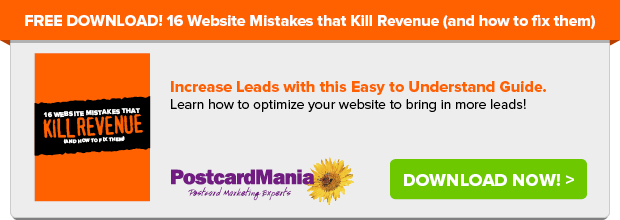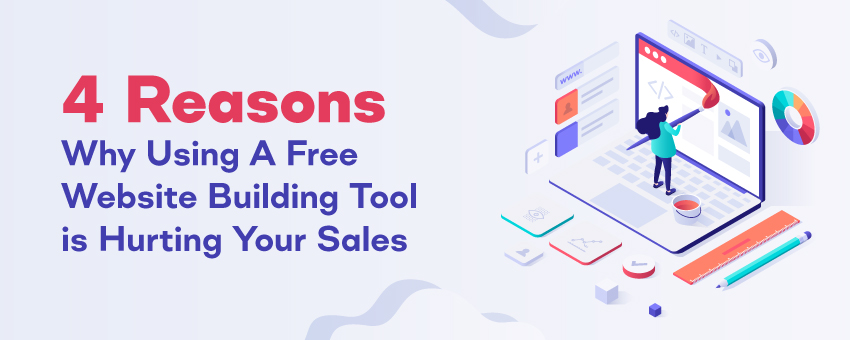4 Reasons Why Using A Free Website Building Tool is Hurting Your Sales
Updated on February 4, 2025We can all agree that having a website is basic Mandatory Business Must-Haves 101, right? It’s vital to your business — the lifeblood of your online presence. What we can’t seem to agree on is how to build that website.
I understand the temptation to use a website builder. Why would you ever pay for something you can do yourself? I mean there are ways to get a site for $1.99 and even FREE!! Also, using a company can be sooo frustrating!!
Let me ask you five questions:
- Which website features ensure it will actually capture the information of visitors and convert them from visitors to real leads?
- What could you be doing with the time you spend making a website?
- Are you ready for the repercussions of a bad website on your bottom line?
- Are you a Search Engine Optimization expert and have a plan that will ensure people find your website?
- Are you aware of what drives someone to hit that back button away from your site and look for a competitor?
If you know the answers, congrats! You’re likely a web developer that doesn’t need my help.
If not, read on to learn why your website is the last place you want to cut corners.
If you’re still reading:
I think it’s fair to assume that you aren’t a website developer — instead, you’re a small business owner or marketer who knows they need a great website to grow their business.
But you might be wondering:
Do I build my website myself? Should I bite the bullet and hire someone? How much is too much to spend?
I can’t directly, knowingly answer those questions for you without sitting down with you and having a conversation about your business.
However, I can give you some guidance on how to assess what goes into building a great business website so that you can make that decision for yourself with confidence.
I also have a LOT of personal experience with this, which is why I sat down to write this in the first place.
I want to be perfectly honest with you:
Most of the website templates out there are not necessarily built from the perspective of a marketer seeking conversion (when people convert from a visitor to lead) or a business owner who wants new business from visitors. I believe those templates are created by people who know how to code, live in foreign countries and have no clue how to make a website effective for an American business and consumers in the US.
I personally review a LOT of my clients’ sites.
Why would I, the CEO of a $60 million business, spend ANY time doing this myself?
Because I want to make sure that my clients are going to get results from the campaigns they buy from me AND 99% of people interested in what is on a postcard will go to the website first to see if they are really interested or not. So, if you’re my client, your website directly affects how well your postcard campaign performs.
I actually have a full-time employee — and this is all she does — review my clients’ sites and send them recommendations that will improve conversion. The number of template sites I see that are terrible is incredible. A small business owner just plopped down money on a campaign with my company and (from a cursory view of their website, I can tell) it will bomb!! So, Jennifer spends all day reviewing sites of small business owners that just paid — BEFORE we mail their cards — so those website changes can get made to help ensure the money they spent with me will pay off and actually bring in new business.
So, those are my motivations for writing this and for helping you understand the tremendous value of a good website for your business.
Getting back to the issue at hand:
Here’s what you need to know about building an effective website for your business:
1. You need to know which website elements transform anonymous browsers into leads that are ready and willing to hear more from you.
Firstly, consumers are expecting a certain experience when they visit a site — and if they don’t get what they are expecting, it can be the end of them being there at all.
They want to LIKE their experience on your website.
Do you ever go to a website and you can’t find what you’re looking for? It’s frustrating! It’s a BAD experience. No one visits websites hoping to have a bad time.
But how can you make sure people like your website? It seems so subjective, right?
Well, it isn’t!
This next part is important, so I’m going to bold it:
A good business website MUST make people feel good about your business — it should improve their affinity and trust for your business. You can’t make them like you if your website is a bad experience.
How you create that affinity, trust and good user experience doesn’t boil down to subjective things like colors or fonts or pictures.
It boils down to something extremely basic:
Familiarity.
Visitors want to learn certain things about you when they visit your website — and our history of web browsing dictates that:
- Certain information should be in certain places
- Certain buttons should act certain ways
- And certain pages should be present and contain certain things
There is a collective consumer expectation on what comprises a good business website.
Deviate from that, and people will have a negative reaction to your website, and you’ll lose interest, visitors, leads and revenue that you could have otherwise converted.
(This article provides 10 elements of a great website and is a good jumping-off point to learn some of the specific features needed to meet those consumer expectations.)
BUT:
— And this is why websites can be SO difficult —
Just having the right stuff in the right place isn’t necessarily enough to make your website effective.
Yes, it will meet consumer expectations and give visitors a good experience, but it ALSO has to work for YOUR needs as a business owner — aka create LEADS for you!
Imagine this:
You’re considering doing some landscaping to your front yard. You find 5 local landscaping companies and start opening tabs and visiting websites. Out of those 5 websites, only 3 websites pass the “good feeling” test. Out of those 3:
- Company 1: Lists their phone number and address in their contact information.
- Company 2: Lists their email, phone number, address and has a form to fill out for a free estimate.
- Company 3: Lists their email, phone number, address, has a form to fill out for $100 off any job, and a “Tell us about your project” form to fill out.
For me, Company 1 is out. I’m not ready for a call. Instead, I will fill out the forms on Company 2’s and Company 3’s websites to see which one will win my business.
Company 2 and Company 3 are successfully using marketing devices (forms, offers) to get MORE LEADS out of their website. They’re creating opportunities for me to raise my hand and opt into the next step.
An effective website MUST accomplish these 2 things:
- Provide a good user experience to raise affinity and trust (by placing design elements in the correct/familiar places)
- Capitalize on that good experience and heightened affinity and trust by turning that visitor into a lead with well-placed, tried and tested marketing devices
Each company accomplished #1, but only Company 2 and Company 3 accomplished #2.
The leap from anonymous website visitor to bonafide interested lead hinges on BOTH being accomplished.
2. You’ll waste a colossal amount of time building something that isn’t as professional as you are.
How long do you think the average effective website takes to build?
It might be a little longer than you think.
Full-time WordPress developer Bill Erickson, who has 15 years experience, estimates it takes 14 weeks at a minimum from start to finish.
His process takes:
- 3 weeks to discover what a business’s needs are to align with the website goals
- 6 weeks to design the pages and test website performance across different operating systems (Mac or Windows), browsers (Chrome, Safari, Firefox, etc) and devices (desktop computers, iPads, smartphones, etc)
- 3 weeks to develop the actual website itself and ensure the design is working towards its goals
- And then 2 weeks of further tweaks and modifications
Raise your hand if your DIY website process was going to include all of the things above.
I doubt many of you raised your hands!
Outside of the time it takes to build a good website, what will you be giving up as you spend more time navigating the murky waters of website design by yourself?
Quick story:
Two recent interactions drove me to write this article.
The first, a doctor and independent business owner. A brilliant woman driven to grow her business. She truly believed that her website was a ripe opportunity to save some money by doing it herself, and I couldn’t convince her otherwise. So I at least convinced her to educate herself on website design.
The second, another brilliant business owner who owns a successful meal prep and delivery service. Again, I tried to convince her to get her website done by a pro, but to no avail. She was another self-starter who dedicated herself to learning a massive amount of technical knowledge to build her own website.
While I very much respect the dedication, hustle and frugality of their respective decisions — and both run moderately successful businesses — I ultimately think they’re both wasting their time and, at the end of the day, hurting their bottom line.
It has been several months since these women have come to see me, their websites are built and yet neither has grown their business in a significant way.
During all these long months of research, they could’ve been driving revenue the best way they know how – through their business!!
The doctor could’ve been seeing more patients, and the meal prepper could have been rolling out vegan and paleo options to expand her base.
While their websites are very attractive, ultimately, it doesn’t matter if a website is aesthetically pleasing or not. It matters if it accomplishes your business goals.
Speaking of which, if you create a terrible website, are you ready for the repercussions it could bring?
3. Your business will be judged one way or another on your website
I can’t tell you how many times I’ve heard, “website design isn’t everything — at the end of the day, it’s the quality of the service I provide!”
I hope you can feel my eyes rolling through the computer. While this isn’t wholly untrue (at least for existing customers), the buying process isn’t that simple anymore.
In a recent survey of online shoppers and buying behaviors, 92% of consumers reported visiting a brand’s website for the first time for reasons OTHER than making a purchase.
These consumers will pass judgment on a website in 50 milliseconds… Meaning that if you have an unhelpful webpage, regardless of how great your service may be, you’re losing that business to someone with a better site…and maybe a worse service!!!
Here are 4 ways your website design is hurting your sales right now.
However, all of this is moot if consumers never find your website in the first place.
4. You don’t know SEO, and neither do the DIY website builders
Search Engine Optimization (SEO) is arguably one of the most essential aspects involved in building a website.
First, let’s break down what SEO is, since it can be such a confusing term for many small business owners:
SEO has to do with search engines finding your site when a person types in certain terms on Google or Bing or any search engine.
Example: If your website can’t be found by typing in terms that consumers will use to find you, your SEO is a problem.
I searched for “kitchen remodel Clearwater” on Google and here is a screenshot of the results:

These 3 companies have done well with their SEO. Had I made the screenshot longer and shown you what lies beneath the map listings, you’d see lots of directories — if you are not listed on those, it’s a problem too.
This is all SEO. Optimizing your website so that search engines find you.
Google and the like are constantly evolving their algorithms to better serve the searcher — not the business owner. That means that as they change, you need to evolve your site, and, in reality, website builders are awful at SEO.
Here are just a few reasons why:
Your on-page SEO suffers — the portion of your website that you can manipulate to improve your search engine ranking — is lost when using website builders.
Website builders take your design instructions and spit out a jumbled mess of code, which means you lose control of the code and structure that go into quality SEO practices.
You have no access to the code to fix it — to continuously improve a website’s SEO, you need access to the “backend,” or the coding behind your website. Website builders only give you access to the “frontend” of the website, aka the parts everyone can see and interact with.
Just imagine trying to fix a car without any access to the engine. No matter how many new wheels or tricked out features you equip it with, it will never run how it’s supposed to — it’s the same idea with your website’s coding.
Your page speed slows down dramatically — the faster your website speed, the better it will be for SEO. Page speed also helps determine what you will pay per click in paid search engine ads, and how your website ranks in organic (unpaid) searches.
The problem with the “drag-and-drop” features that most website builders offer is that it clogs up the HTML code, which causes the browser to “lock-up.” The “features” you include, the more time it takes the browser to process the page and the worse it is for SEO.
If you’re looking to get more into the technical side of why website builders are terrible for SEO, check out this blog.
Webpage builders, while easy to use, have too many problems.
They’re more for artists and photographers to showcase their portfolios — not for serious businesses looking for a website that will help them grow their bottom line.
I don’t tell you any of this to scare you. I want you to use what resources (time and money) you have as effectively as possible to help increase leads and sales, help your business thrive and ultimately grow and reach the next level.
In case you are interested in hiring a professional who takes all of the above into consideration to provide you with a website that is an effective business tool, we offer an affordable website design service where all the above, and much more, will be taken care of. You can look at our website portfolio here.
Our website design service is crazy affordable and makes efficient websites that generate results. In fact, we’re ranked as one of the top website designers in the Tampa Bay, FL area where we’re located! Check out the details on our website design services here.
Even if you decide not to use us, at the very least, find another way to build a website. You’ll be hard-pressed to find a better value than ours, but I invite you to try! I always think a business owner will ultimately do what’s truly best for their business when properly educated.
Which is why I write these blogs to do just that!
If you have any questions or concerns, don’t hesitate to reach out to us at all 800-628-1804 for a FREE, no-obligation consultation!
If you have questions about anything I’ve discussed here, you can always email me at Joy.Gendusa@PostcardMania.com or just leave a comment below.






